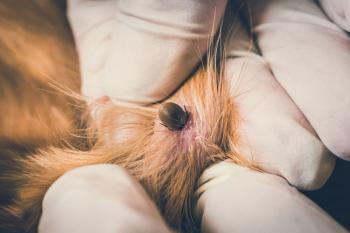
A case for year-round flea control
Dr. Byron Blagburn discusses how the control of fleas and flea-induced diseases requires a considerable effort by both pet owners and veterinarians.
Control of fleas and flea-induced diseases requires a considerable effort by both pet owners and veterinarians. Although convenient and effective flea control products are available, successful flea management remains a challenge for many pet owners. The reasons we still experience flea problems can usually be explained by a lack of understanding of the flea life cycle or a lack of owner compliance.
Flea life cycle
First, let's look at aspects of the flea life cycle that are important in flea development and survival. Female fleas begin egg production within 24 to 36 hours of taking their first blood meal. Females reach peak egg production at 40 to 50 eggs per day — that's about 1,300 eggs during their first 50 days on a host. They continue to produce eggs at a gradually declining rate for more than 100 days. The entire life cycle can be completed in as little as 12 to 14 days, or it can be prolonged up to 174 days, depending on temperature and humidity.
It's easy to see that if flea infestations are left uncontrolled for just a brief period, flea populations (first in the environment, then on the pet) can increase at astonishingly rapid rates. That said, in many regions of the country — and indoors in all regions — flea development usually slows during the cooler temperatures of late fall, winter and spring months. But even during these times, development does not cease entirely.
Flea control compliance
The second major reason for failure to control fleas is the presumption that since fleas are not visible, prevention can be discontinued. However, the number of fleas visible on a pet represents only 5 percent of the total number of fleas on the pet and in the environment. The fleas are there, even if you are not seeing them.
Recent research insights
Now for a more convincing argument for year-round control: Colleagues and I have been conducting research for several years on the susceptibility of fleas from around the world to modern flea control products — specifically imidacloprid, a topical flea adulticide. The purpose of this research is to monitor the susceptibility of national and regional isolates of fleas to this commonly used flea control product. Our intention is to detect if and when resistance develops to imidacloprid and to develop countermeasures should we document resistant fleas. Fortunately, we have yet to identify flea isolates anywhere in the world that are resistant to imidacloprid. That is good news. However, some unexpected additional information emerged from our examination of more than 1,300 flea isolates.
We noticed that the greatest numbers of fleas were sent to us during the months of August, September and October (Figure 1). Since our submitted samples are most numerous during those three months, we can presume that that is an indication of the magnitude of the flea populations on pets during those times. The abiotic factors (temperature, humidity, soil type) that drive the flea life cycle are the reasons that as we move from spring to summer to early fall, the numbers of submitted samples increases. As temperatures and relative humidity increase, the fleas on dogs or cats are better able to reproduce. Therefore, even a small (often unnoticed) population can become an overwhelming problem in a short period.
Figure 1: Flea isolates collected by month (2001-2008)
The numbers of submitted samples (Figure 1), which are a reflection of the total number of fleas on pets, were least in December, January, February, March and April. Lower temperature and humidity results in decreased reproductive rates of fleas at these times. This does not imply that fleas have disappeared. It simply means that rates of reproduction have declined and that many fleas lie waiting in the environment for better conditions in which to reproduce. These findings suggest that veterinarians need to be more adamant about year-round use of products, and clients need to be more compliant in using flea products year-round to prevent the surge in populations evident in August, September and October.
Improving compliance with year-round prevention
So what can we tell clients who are reluctant to use flea products year-round? A good place to start is to readdress the flea life cycle to ensure that clients understand that adult fleas on their pets represent only a small percentage of the total flea population on their pets and in the environment. Also, clients need to appreciate that if they fail to administer flea control products during these so-called "down times," it will require more effort (in addition to tolerance and patience) in the future to eliminate fleas. Keep in mind that the points emphasized in this article apply to pets in the Northern Hemisphere. Seasons are reversed in the Southern Hemisphere. The late-summer and fall surge would occur in February, March and April in those regions.
If we take into account the new information about fleas from our research (Figure 1), the developmental cycle of fleas and the availability of safe, effective and convenient flea control products, the case for year-round use of flea control products is convincing.
Dr. Blagburn is a Distinguished University Professor at Auburn University's College of Veterinary Medicine.
Suggested reading:
> Blagburn BL, Dryden MW. Biology, treatment, and control of flea and tick infestations. Vet Clin North Am Small Anim Pract 2009;39(6):1173-1200.
> Dryden MW, Rust MK. The cat flea — biology, ecology and control. Vet Parasitol 1994;52(1-2)):1-19.
> Blagburn BL, Dryden MW, Payne P, et al. New methods and strategies for monitoring susceptibility of fleas to current flea control products. Vet Ther 2006;7(2):86-98.
Newsletter
From exam room tips to practice management insights, get trusted veterinary news delivered straight to your inbox—subscribe to dvm360.




